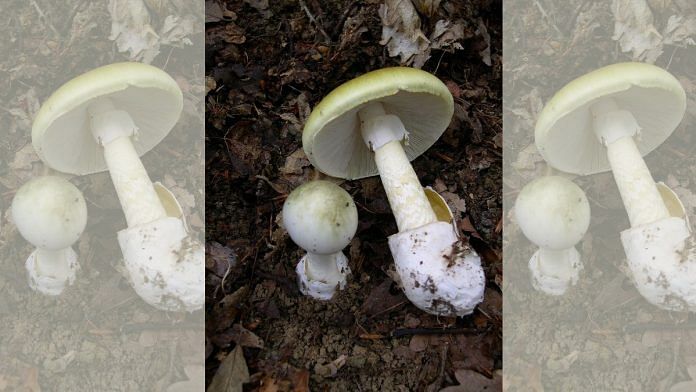New Delhi: Scientists may have found an antidote for the world’s most poisonous mushroom, Amanita phalloides, commonly known as the ‘death cap’. Not only has it been the main cause of deaths due to mushroom poisoning in Assam and Meghalaya, it is also responsible for 90 per cent of such fatalities across the world every year.
Last year, 16 people in Assam reportedly died within two days of being hospitalised after eating this type of mushroom. Another 20 people in the state had lost their lives after consuming the poisonous funghi in 2008. In 2020, at least six people reportedly died after consuming death cap mushrooms in Meghalaya.
A group of Chinese and Australian researchers has now discovered a potential antidote — indocyanine green (ICG), which is a dye used in medical diagnostics. They have also figured out the mechanism of the biochemical pathway in the human body which allows the mushrooms’ toxins to enter the cells. The potential antidote, the researchers found, inhibits this pathway and avoids kidney and liver failure caused by the mushroom. Their findings, which have been peer-reviewed, were published in leading science journal Nature Tuesday.
Indocyanine green has been used in medicine since the mid-1950s for a variety of applications across cardiology, ophthalmology, and neurosurgery. It is approved by the US Food and Drug Administration and the European Medicines Agency, and is considered safe for medical imaging.
While it has not yet been tested on humans, indocyanine green has shown “great potential” when used on mice, according to the study. “This molecule holds immense potential for treating cases of human mushroom poisoning and could mark the first-ever specific antidote…,” Qiaoping Wang, the study’s lead author told AFP. “It could save many lives if it is as effective in humans as in mice.”
Symptoms of death cap mushroom poisoning generally occur between 6 to 24 hours and include abdominal pains, nausea, vomiting and diarrhoea. However, the toxin works fast and in a couple days causes extensive liver damage.
Treatment should ideally start as soon as the symptoms appear, which include administering fluids, surgically removing the mushroom or giving activated charcoal to the patient. The mortality rate due to mushroom poisoning stands at 2 to 30 per cent and death can occur in a week or two.
Also Read: Artificial sweeteners don’t aid weight loss, may increase diabetes, heart disease risk, says WHO
‘Blocks liver, kidney damage’
Known as the ‘killer of kings’ for centuries, the death cap mushroom is said to have been responsible for the deaths of Roman Emperor Claudius in AD 54 and Holy Roman Emperor Charles VI in 1740. It can grow up to 15 cm tall, and is tan or yellow-green in colour.
The death cap closely resembles edible mushrooms, which makes it difficult to identify. According to a 2020 report by Scroll, it was the main cause of deaths among Assam’s impoverished tea tribe communities — who forage and eat wild mushrooms as a source of protein — and even consuming one or two pieces of it could be lethal.
According to the latest study, the most fatal component of the death cap is the α-amanitin toxin. While it is deadly, there is not enough understanding around how it poisons humans. However, in a first, the scientists discovered that an enzyme, STT3B, gives α-amanitin its toxicity but its toxic effects can be inhibited by indocyanine green (ICG).
The scientists used a method that they had developed a few years ago to find an antidote for jellyfish venom. They created a pool of human cells, each with a different mutation in their gene. Then, they tested which mutations helped the cells survive any exposure to α-amanitin.
When they found that cells without the STT3B enzyme or protein are able to survive α-amanitin, they further targeted the N-glycan biochemical pathway which it is a part of. According to different studies, it was observed that bacterial toxins and viruses bind N-glycans and this facilitates their entry into the target cells.
STT3B is a key enzyme which has been considered a therapeutic target for treating cancers, but so far, nobody was aware that STT3B played a part in α-amanitin toxicity, and Wang said, “We are totally surprised by our findings.”
Following this, the team looked at 3,200 chemical compounds to find a suitable one that could block the action of STT3B. They discovered that ICG was a potential candidate as only about 50 per cent of mice treated with the dye died from α-amanitin poisoning, compared with 90 per cent of those that were not treated.
By injecting three doses of ICG into mice at 4-hour intervals, the scientists found that ICG concentrated itself in the animal’s liver. Since the toxin mainly targets the liver and the kidney, the damage caused by it was assessed, where the researchers noted that ICG significantly blocked liver and renal damage, significantly improving the survival of the mice.
A further assessment of time intervals revealed that ICG needs to be administered as early as the poisoning occurs, to show maximum efficacy. Time intervals before poisoning and ICG injection of 8 or 12 hours limited the effect of the antidote, but intervals between 1 and 4 hours showed better results.
Since the chemical is known to be safe at certain dosages, the researchers hope that they can soon start testing it on people.
(Edited by Anumeha Saxena)



